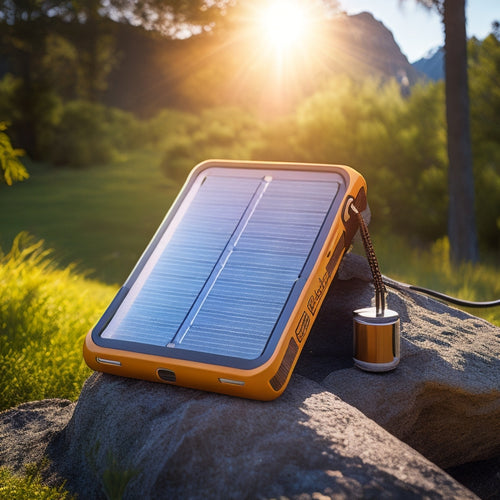
Top Portable Power Sources for Emergencies
Share
When you're faced with an emergency, having a reliable portable power source is crucial. Look for units with at least 300-500 watts of continuous power to support essential devices. Opt for models featuring multiple output ports, including USB-C and AC outlets for versatility. Lithium-ion batteries are preferred for their longevity and quick charging capabilities. Reflect on solar charging options for renewable power during outages. Assess your devices' power needs to guarantee compatibility. Brands like Jackery, Goal Zero, and Anker offer top-rated models to evaluate, with features designed to optimize efficiency and performance. You'll uncover even more important perspectives ahead.
At a Glance
- Look for portable power sources with multiple output ports, including USB-A, USB-C, and AC outlets for diverse charging needs during emergencies.
- Consider units with solar charging capabilities to ensure renewable energy access during power outages or outdoor activities.
- Evaluate battery capacity in watt-hours (Wh) to determine how long devices can run before needing a recharge.
- Choose lightweight lithium-ion batteries for longer lifespans and rapid charging to enhance portability and efficiency.
- Trusted brands like Jackery, Goal Zero, and Anker offer reliable portable power sources with essential features for emergencies.
Versatile Charging Options Available
When considering portable power sources for emergencies, you'll find that solar charging capabilities greatly improve their utility.
These systems often support multiple device compatibility, allowing you to charge everything from smartphones to larger electronics seamlessly.
Reliable solar power banks are essential for camping and outdoor excursions, providing a sustainable energy source and reducing reliance on fossil fuels eco-friendly benefits.
Solar Charging Capabilities
With the increasing demand for reliable energy sources during emergencies, solar charging capabilities have emerged as a versatile solution. You'll find that portable solar integration offers unique advantages, allowing you to utilize the sun's power anywhere.
These systems are designed to be lightweight and compact, enabling easy transport and setup, which is crucial when every second counts.
One of the key factors to evaluate is solar panel efficiency. Higher efficiency ratings mean more energy generation in less time, ensuring your devices stay charged even in less-than-ideal conditions.
Look for solar chargers that optimize their performance through advanced technologies like monocrystalline panels, which typically outperform their polycrystalline counterparts.
When evaluating solar charging options, also assess the charging speed and the capacity of the power bank you're using. A well-matched solar charger can greatly reduce downtime and enhance your preparedness.
In an emergency, having the ability to recharge your devices using sunlight gives you a level of freedom and independence that conventional power sources can't provide.
Multiple Device Compatibility
In emergency situations, having a portable power source that can charge multiple devices simultaneously is essential for maintaining communication and powering critical equipment.
You'll want to invest in a unit with excellent device compatibility to guarantee it meets your diverse needs. Look for portable power sources that feature a variety of charger types, such as USB-A, USB-C, and AC outlets, allowing you to power everything from smartphones and tablets to laptops and medical devices.
When evaluating options, consider the total output wattage and the number of ports available. The more ports and higher wattage, the better you can manage simultaneous charging without sacrificing speed.
Some models even include wireless charging capabilities, providing an added layer of convenience.
Additionally, pay attention to compatibility with different battery technologies. A sturdy power source should accommodate lithium-ion batteries, which are commonly used in modern devices, making sure you're not limited when it matters most.
Ultimately, by prioritizing multiple device compatibility and versatile charger types, you'll enable yourself to maneuver through emergencies with confidence and efficiency.
Reliable Power in Crisis
When facing a crisis, having a reliable power source can mean the difference between chaos and stability.
You need to evaluate essential features like capacity, portability, and charging speed to guarantee your devices stay operational.
Understanding the matching power needs based on your devices' consumption is vital for effective usage.
Exploring the best options available today can help you make informed decisions for any emergency situation.
Essential Features to Consider
Choosing the right portable power source for emergencies requires careful consideration of several essential features that guarantee reliable power in vital situations.
First, evaluate the power capacity, typically measured in watt-hours (Wh). This determines how long your devices can operate. Ascertain it meets your needs for charging multiple devices or running larger appliances.
Next, look into weight considerations. A power source that's too heavy can hinder mobility, especially during emergencies when you need to be agile. Portability features, such as built-in handles or compact design, can greatly enhance ease of transport.
Additionally, consider the number and types of output ports. Versatile output options, like USB-C and standard AC outlets, allow you to charge various devices simultaneously.
Battery type is another important factor. Lithium-ion batteries offer longer lifespans and quicker charging, making them ideal for emergencies.
Best Options Available Today
With the right features in mind, selecting a portable power source for emergencies can greatly impact your ability to stay connected and powered during a crisis. When considering your options, prioritize units that offer at least 300-500 watts of continuous power. This range typically supports essential devices like phones, laptops, and small appliances, vital for effective emergency preparedness.
Look for models equipped with multiple output ports, such as AC, USB, and DC, allowing versatile power management for various devices. Lithium-ion batteries are preferable for their lightweight design and longer lifespan compared to traditional lead-acid options. Brands like Jackery, Goal Zero, and Anker stand out in this space, offering reliable models that cater to different needs.
Additionally, consider solar-compatible units for renewable energy access during extended outages. These options not only provide autonomy but also align with the freedom-oriented mindset of self-sufficiency.
When choosing a portable power source, think about your specific needs and how each product's features align with your emergency plans. By investing in the right equipment, you guarantee that you can maintain essential communications and power critical devices, even in dire circumstances.
Key Specifications Overview
When choosing a portable power source for emergencies, understanding battery capacity is essential to guarantee it meets your energy needs.
Additionally, evaluating energy consumption patterns can help you determine the right capacity for your specific requirements.
You'll also want to take into account the output port options, as they determine what devices you can power and how efficiently.
Evaluating these key specifications will help you make an informed decision for your specific requirements, particularly regarding energy consumption patterns.
Battery Capacity Considerations
Battery capacity is an important factor to contemplate when selecting a portable power source for emergencies, as it directly impacts how long your devices can run before needing a recharge.
Understanding battery types is essential, as different chemistries—like lithium-ion, lead-acid, and nickel-metal hydride—offer varying capacities and efficiencies.
For instance, lithium-ion batteries tend to have higher energy density, meaning they can store more power in a smaller size, which is vital when you're trying to maximize portability.
You'll also want to assess the charging speeds, as faster charging can be a lifesaver in emergency situations where time is of the essence. Some power sources feature rapid charging technology, allowing you to get back to full capacity quickly.
When evaluating battery capacity, look for milliamp hours (mAh) or watt-hours (Wh) as indicators of how much energy can be stored. A higher rating typically means longer runtime for your devices.
Ultimately, considering these factors will help you choose a portable power source that aligns with your needs, providing you the freedom to stay connected and powered up in emergencies.
Output Port Options
A variety of output port options can greatly influence the versatility and usability of a portable power source during emergencies. Understanding the different output types available is vital for ensuring you can charge multiple devices quickly and efficiently.
Here's a quick overview of common output port types and their associated charging speeds:
| Output Type | Typical Devices | Charging Speed |
|---|---|---|
| USB-A | Smartphones, Tablets | 5V/2.4A (12W) |
| USB-C | Laptops, Modern Gadgets | 5V/3A (15W) or higher (up to 100W) |
| AC Outlet | Appliances, Power Tools | 110V/300W or more |
Choosing a portable power source with a variety of output types allows you to cater to your specific needs during emergencies. The charging speeds of these ports determine how quickly you can restore power to your devices, which is essential in critical situations. Prioritizing flexibility in output options not only enhances your preparedness but also grants you the freedom to rely on your devices when it matters most.
Assess Battery Capacity Requirements
To assess battery capacity requirements, first, determine the power needs of each device you plan to use.
Understanding the energy characteristics of different battery types, such as lithium-ion batteries, which are known for their high energy density and efficiency, can also guide your decision.
Next, calculate how long you'll need to run these devices to establish the total energy consumption.
This data will help you select a portable power source that meets your emergency needs effectively.
Determine Device Power Needs
Understanding the power needs of your devices is essential for selecting the right portable power source during emergencies. To make an informed choice, you'll first need to assess the power consumption of each device you plan to use. Check the wattage or voltage ratings, typically found on the device label or in the user manual. This helps you gauge how much energy each device requires.
Next, consider device prioritization. Not every device holds the same level of importance during an emergency. For instance, a smartphone might be critical for communication, while a laptop could be less urgent. List your devices in order of necessity and calculate their combined power consumption to determine the total demand.
Once you know the total wattage needed, you can compare that against the capacities of available portable power sources. Verify the power source can handle peak loads, especially if multiple devices are used simultaneously.
Calculate Usage Duration
Calculating usage duration is vital for ensuring your portable power source meets your needs during an emergency. To do this effectively, you'll need to assess both your device's power requirements and the capacity of your power source.
Start by determining the watt-hours (Wh) your devices consume. For example, if a device uses 10 watts and you plan to use it for 5 hours, it will require 50 Wh.
Next, evaluate the capacity of your portable power source, typically measured in Wh or amp-hours (Ah). To find the usage duration, divide the power source's capacity by the total wattage of your devices. If your power source has a capacity of 200 Wh, you can run that 10-watt device for approximately 20 hours under ideal conditions.
Keep in mind that power management plays a fundamental role in this calculation. Using energy-efficient devices can extend your available usage duration considerably.
Additionally, some power sources may offer features like smart charging that optimize energy use, further enhancing efficiency. By understanding these metrics, you'll maximize your power source's potential, ensuring you maintain freedom and functionality when it matters most.
Longer Lifespan Than Competitors
When you compare portable power sources, enhanced battery technology stands out as a key factor in achieving a longer lifespan than competitors.
These advancements not only increase energy density but also improve charge cycles, allowing your device to last considerably longer during emergencies.
Understanding these technological improvements can help you make informed decisions about which power source best meets your needs.
Enhanced Battery Technology
Advancing battery technology has revolutionized portable power sources, providing products with longer lifespans than many competitors. With the rise of advanced energy storage solutions, you can now rely on power banks and generators that not only charge quickly but also maintain their efficiency over time.
Lithium ion advancements have played a vital role in this change, enhancing energy density and cycle life. These modern batteries feature improved thermal management and reduced self-discharge rates, allowing you to utilize energy when you need it most.
You won't have to worry about your devices losing power during key moments, thanks to innovations like smart battery management systems that optimize charging cycles and prolong overall lifespan.
Moreover, the lightweight nature of these enhanced batteries guarantees portability without compromising performance. When you're out in the field or facing emergencies, the last thing you want is to be burdened by heavy equipment.
Frequently Asked Questions
Can Portable Power Sources Be Used to Charge Electric Vehicles?
Yes, portable power sources can charge electric vehicles, but their charging capacity varies. Confirm the power source's output matches your vehicle's compatibility for efficient charging. Check specifications to optimize performance and maintain charge longevity.
How Do I Maintain My Portable Power Source for Longevity?
To maintain your portable power source for longevity, focus on battery care. Regularly check charge levels, avoid extreme temperatures, and follow maintenance tips like cleaning contacts and storing it in a cool, dry place.
Are Portable Power Sources Safe for Indoor Use?
When you're indoors, the air's still and quiet. Portable power sources can be safe if they have features like built-in ventilation and low heat generation. Always check manufacturer guidelines to guarantee indoor safety and proper usage.
What Is the Average Recharge Time for Portable Power Sources?
The average recharge time for portable power sources varies based on battery capacity and solar charging efficiency. Typically, it ranges from a few hours to a full day, depending on sunlight availability and the device's power requirements.
Can I Use My Portable Power Source While It's Charging?
Did you know that 40% of portable power sources allow simultaneous use while charging? However, many have charging limitations that can affect their functionality, so always check your device's specifications to guarantee safe operation.
Explore More
In a world where you never think a power outage will happen to you, having a reliable portable power source is surprisingly essential. You might find it ironic that in our tech-savvy lives, the simplest need for power can be the most overlooked. By evaluating your battery capacity and choosing the right specifications, you can guarantee you're ready for any unexpected crisis. After all, it's better to have backup power and not need it than to need it and not have it.
Related Posts
-

Top Eco-Friendly Camping Equipment for a Sustainable Adventure
When you're camping with the planet in mind, opt for eco-friendly gear like tents made from recycled materials and bi...
-

Why Outdoor Solar Lighting Systems Are Sustainable
Outdoor solar lighting systems are sustainable because they utilize renewable energy, drastically reducing your carbo...
-

Fastest Solar Chargers for Emergency Power
When choosing the fastest solar chargers for emergency power, you need to focus on features like rapid charging capab...


